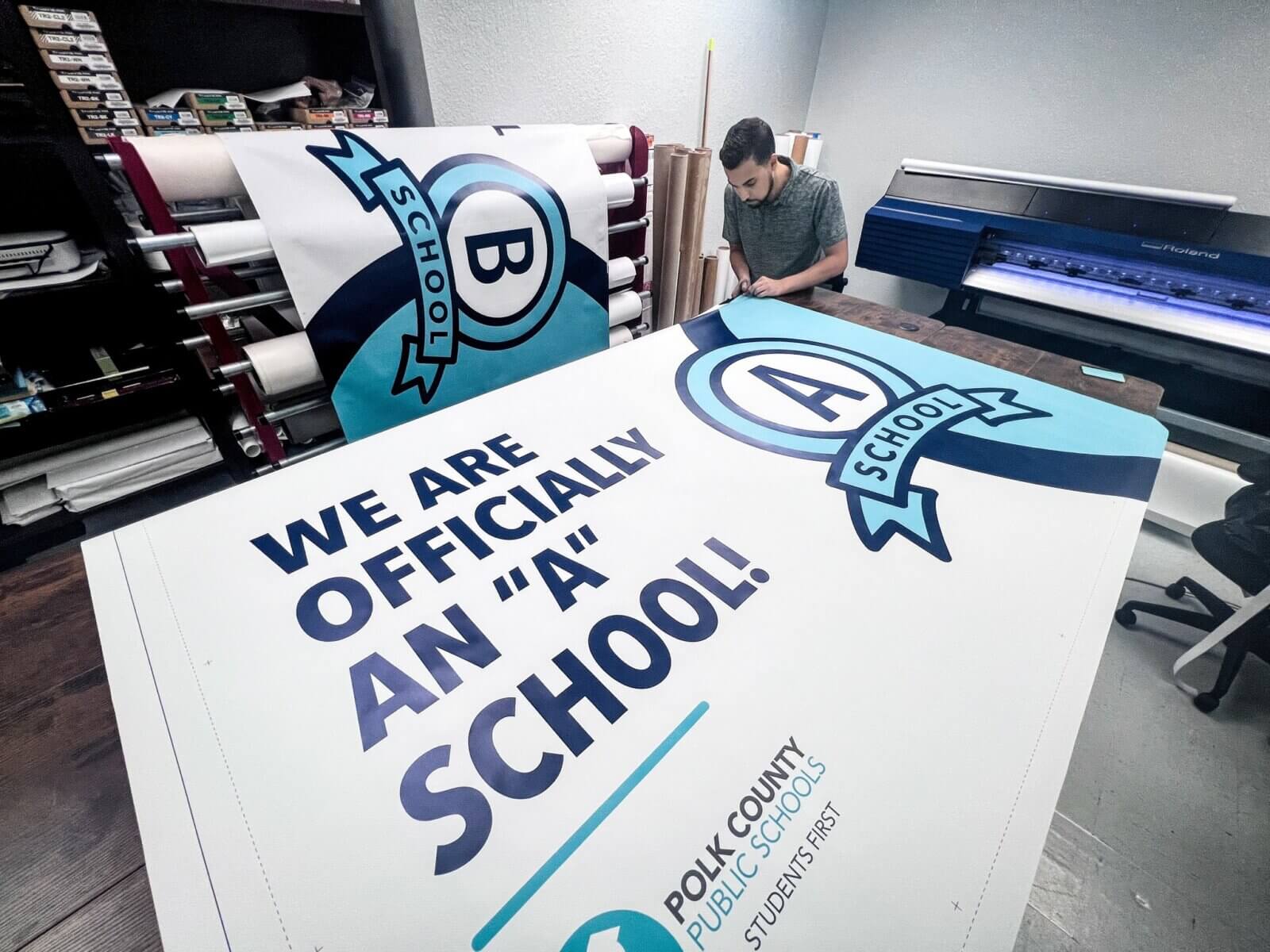Polk County Public Schools Improve District Grade
Polk County Public Schools Superintendent Frederick Heid has been at the top for four years. During this time, he has led the charge to improve the district’s annual grade back to a B.
Using data, coupled with understanding, has resulted in the district improving to a B for the 2024-25 school year. Polk County Public Schools (PCPS) improved from a C, making it the first time since 2019-2020 the district has received a B from the Florida Department of Education.

Heid credits monitoring along with what he calls strategic shifts like:
- Alignment of Interventions to Research-Based Practices. “We took a hard look at the interventions being used across schools and ensured they were grounded in evidence-based practices. It wasn’t just about doing more — it was about doing what works, consistently and with fidelity.”
- Data-Informed Decision Making. “We prioritized developing a strong culture of data communication. This includes making sure data is transparent, timely and actionable for teachers, school leaders and district staff. Everyone knows where we stand and where we’re headed — and that clarity drives improvement. But, I must clarify that we are not blinded by the data. We realize that many other factors contribute to successful outcomes. So, a balanced approach is warranted.”
- Instructional Coherence and Alignment. “We placed a strong emphasis on ensuring that the instruction students receive in the classroom is aligned with the expectations of state assessments. In short, we focused on delivering grade-level, standards-aligned instruction every day so that students aren’t surprised by how they’re assessed. This work supports equity across the district by ensuring that every child receives access to rigorous instruction, regardless of their zip code.”
Ongoing Commitment
Heid was unanimously selected as the new superintendent in April 2021. His style of leadership has everyone rowing in the same direction. But, he said, it’s not “about convincing people to row — most educators already want to do the right thing for kids. In 27 years of working in public education, I’ve rarely encountered someone who wasn’t committed to improving outcomes for students. The challenge isn’t the desire — it’s aligning effort, time and systems to that shared commitment. That takes leadership, trust and time.”

He sets expectations and then gives his staff space and time. He has three mantras:
- Empowerment with Accountability. “I don’t micromanage. I set clear expectations and define the goals. But I also empower my team to determine the best path to reach them. That autonomy, however, comes with an expectation of accountability. People thrive when they are trusted to lead — and they rise to the challenge when they know results matter.”
- Balanced Change Management. “I believe in continuously taking the pulse of the organization during times of change. Systemic improvement can’t be achieved through pressure alone. There must be a balance between pushing for necessary change and recognizing what is realistically achievable. Sustainable progress requires pacing, transparency and understanding the limits of organizational capacity.”
- Consistency and Sincerity. “People follow consistency. I’ve remained steadfast in our goals and sincere in our commitment to students and staff. That steadiness, particularly during difficult times, builds trust and encourages others to stay the course.”
Graduation Rate Improvement

Several of the schools that improved their grades were high schools, leading in improving the district’s graduation rate from 78% to 82%.
“Our high schools have made tremendous strides in several key performance areas — particularly in acceleration (dual enrollment, AP, industry certifications), science achievement, civics and graduation rates. There’s been a renewed focus on:
- Expanding access to college and career acceleration opportunities while ensuring students are successful in those courses.
- Closing instructional gaps in core content areas through targeted interventions and improved instructional materials.
- Building stronger systems for student support, including mentoring, credit recovery and early warning systems, that help keep students on track to graduate.”
The improvements took time and effort, Heid said. “They’re the result of strategic leadership at the school level and a district commitment to supporting high schools with the tools and autonomy they need to succeed.”
In a press release, Polk State College said all three of its collegiate high schools achieved As for the first time.
Polk State Lakeland Gateway to College Collegiate High School received its first grade – a B – last year after changing its charter and mission. It improved to an A this year, joining sister schools Polk State Chain of Lakes Collegiate and Polk State Lakeland Collegiate.
“This is an exciting time for our collegiate high school as we continue our standard of excellence and expand opportunities for our students,” Gateway Principal Meesha Downing-Townsend said in the release. “This year’s school grade is the first of two consecutive A grades needed for Gateway to add a 10th-grade cohort in 2026-2027.”

Workforce Education
Leann Bennett, the school district’s Senior Director of Career, Technical and Adult Education (CTAE), said her department has focused on three initiatives to support workforce development and adult technical education. Those are:
- “Program Improvement Plans (PIPs) were introduced to help high school Heads of Programs track student progress and certification success. This ensures alignment with workforce needs.
- “Reserve funds were used to modernize equipment and instructional materials, while also investing in professional development to enhance hands-on learning.
- “The district strengthened partnerships with local employers and agencies, such as the Central Florida Development Council, Polk Vision and ConnectEd Polk, to offer workplace education, business site visits, student internships and teacher externships.”
Those changes are helping, Bennett said. “I believe the changes we’ve made — especially strengthening Career and Technical Education (CTE) pathways — have positively impacted the district’s graduation rate. When students see a clear connection between their education and real-world careers, they’re more engaged and motivated to complete their programs. By tracking progress and focusing on industry certifications, we help students stay on track and graduate with valuable credentials. Our Program Improvement Plans and strong industry partnerships also create a supportive environment that encourages student success.”

Polk County Public Schools Partnerships
Beyond organizations, the district works with Polk companies “to prepare students for trade careers — and the results are promising,” she said. “Institutions like Traviss Technical College and Ridge Technical College have cultivated strong partnerships with local employers to strengthen Polk County’s skilled trades workforce. These collaborations are deeply embedded in program design, curriculum alignment, and hands-on training opportunities. One example is a partnership with Mosaic. It has supported student onboarding by donating additional training aids — enhancing both the learning experience and job readiness.”
The district also uses career academy advisory boards at the secondary level. They “play a vital role in shaping programming,” Bennett said. “A standout example is the partnership with the Polk County Builders Association. It supports construction-related academies and helps ensure students are learning skills that match real-world job demands.”
Future Goals
Her goal for the next five years “is to strengthen and expand our offerings to meet Polk County’s evolving workforce needs,” she said. “This may include developing new programs in high-skill, high-wage and high-demand fields while conducting annual reviews to ensure quality and relevance. We aim to respond directly to local employment demands by increasing access to dual enrollment and industry certifications. And, by providing more hands-on learning opportunities.”

Her department also will “continue to build capacity through data-driven decision-making and professional development for educators,” she said. “Deepening partnerships with local employers and advisory boards will remain a priority to ensure our students graduate career-ready, and our programs stay aligned with industry expectations.”
The work goes beyond preparing students for their first or second job, Bennett said. “We’re focused on building a future-ready workforce. The CTAE department is committed to ensuring all students, regardless of background, have access to high-quality, hands-on learning.
“We’re expanding access to rigorous CTE programs, even at the elementary level, and conducting regular reviews to ensure alignment with high-demand careers. We continue to invest in teacher training and industry-standard equipment, while also strengthening rural access through targeted funding. Additionally, our Career and Technical Student Organizations (CTSOs) like FBLA, FCCLA, FFA, HOSA and SkillsUSA are helping students develop leadership and employability skills through real-world experiences and community engagement.”
Striving For An “A” Grade
Heid is unsure how long it will take the district to achieve A status, but he won’t stop working toward that goal.
“I’ll be clear: We won’t get there without our families,” he said. “To become an A-rated district, several things must align,” including:
- Daily Attendance and Family Engagement. “We need students in school every day, and we need families reinforcing expectations at home. Academic growth is a partnership, and student success requires consistency, both in the classroom and at home.”
- Recruitment and Retention of High-Quality Staff. “We must remain competitive with surrounding districts in terms of compensation and support to attract and retain the staff we need — teachers, paraprofessionals, bus drivers, all of it.”
- Stability in State Policy. Consistent and equitable state funding, a clear and stable assessment framework and reliable curricular expectations are all essential. Constant shifts in these areas undermine long-term planning and student success.”
The school district is on the right path, he said, and he’s proud of the progress it has made during his tenure.
“The ‘A’ is our target — but it’s not about chasing a grade. It’s about continuing to focus on what matters: strong instruction, student learning, and building a system that delivers for every child,” he said. “If we stay focused on that, the grade will follow.”
… but it’s not about chasing a grade. It’s about continuing to focus on what matters: strong instruction, student learning, and building a system that delivers for every child
Superintendent Fred Heid



